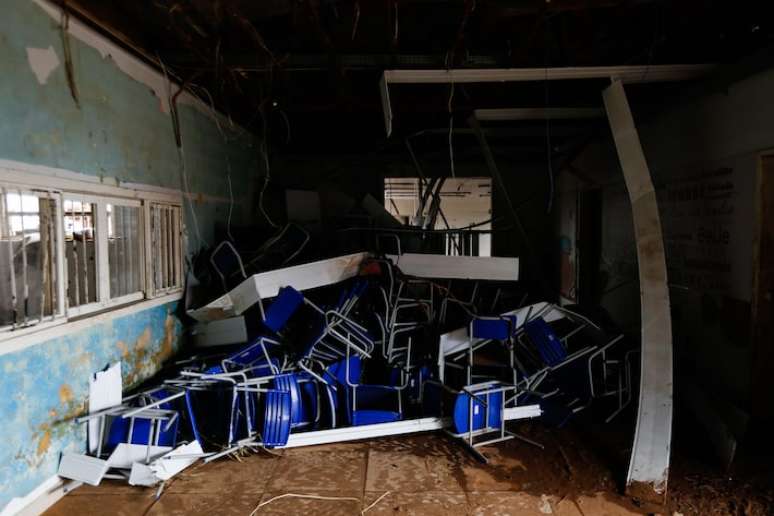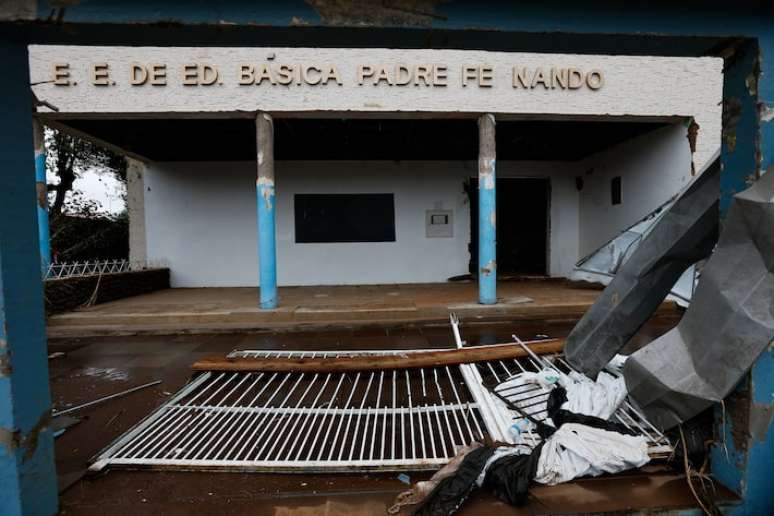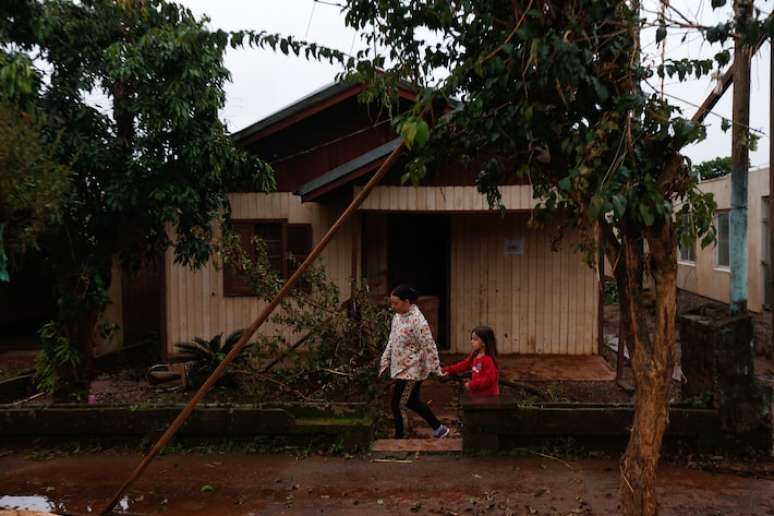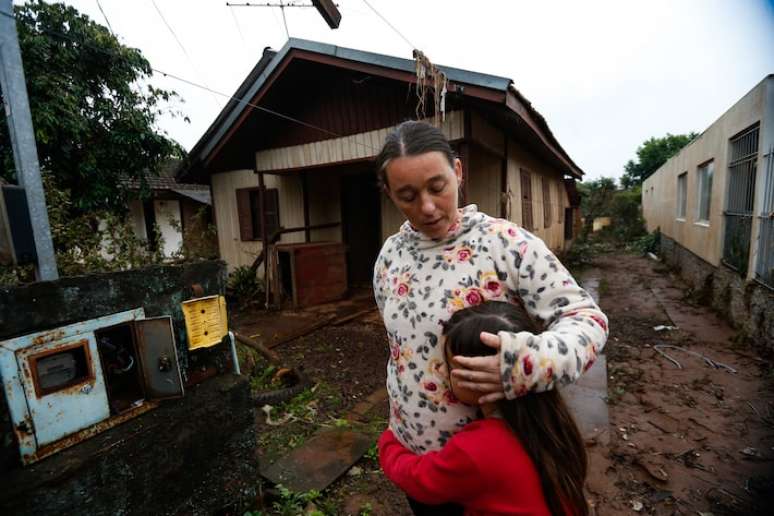The floods hamper the functioning of more than a thousand educational units. Families fear the effects on children and teenagers, and governments say they are taking steps to make operations sustainable
SPECIAL SENT TO ROCA SALES (RS) – At 33 years old, Darlise Rosa has up to the 7th year of education and six daughters of school age. Resident of Roca Sales, in the Taquari Valleyhis house was condemned by Civil protection after the rains that hit the region. Despite the drama of seeing her possessions destroyed (some of which were still paid for in installments), the cook leaves room for a non-material concern.
“Their future is in school. I talk to them every day. I don’t want to see them suffer like me and their father. I only work in the kitchen and I don’t want that life for them. I want them to study, to have a good future” , Darlise said Estadao.
With most classes suspended, learning at risk, children and teachers shaken, the school network is in Rio Grande do Sul it feels like we’re back in 2020, when the covid-19 pandemic schools closed throughout the country, however, the panorama is the one recorded this week, after a historic flood hit the state and affected at least 378 thousand students in the state network alone, once again leaving part of this generation without access to education .
One of the institutions that has fallen into rubble is the Padre Fernando State School, where three of Darlise’s six daughters study. The school was first affected during the floods in September last year, when students began studying in the parish hall of one of Roca Sales’ churches. With the new flood at the beginning of May, the students’ hope of returning to the original building disappeared with the waters.
“I had talked to the girls so that we could gather the parents of Escola Padre Fernando and organize a protest to see if they could fix the school. Then this flood came again and it only made the situation worse”, she complains.

Data from the state Department of Education shows that of the 2,338 schools in the network, 1,058 were affected in some way in 248 municipalities in Rio Grande do Sul. Impacts range from damage to the school facility to transportation and access issues, or to units serving as homeless shelters.
Data on affected schools (damaged, used as shelters, with transportation problems, access problems and others):
- 1,058 schools;
- 248 municipalities;
- 378,887 students affected;
- 552 schools with 212,880 students enrolled were damaged;
- 89 schools that act as shelters.
In this context, the authorities are rushing to try to promote alternatives to reorganize the network, ranging from the transfer of students to other schools to the installation of Internet antennas and the expansion of hybrid teaching, which has been one of the tools used during the pandemic.
Last Tuesday, 14th, the Ministry of Education (MEC) Published on official diary of the Union a decision of the National Council of Education (CNE) which allows the school calendar in Rio Grande do Sul to be made more flexible. Consequently, schools will not be obliged to respect a minimum number of school days as long as they respect the workload foreseen for each of the teaching phases.
The MEC also opened an extraordinary credit of R$46.1 million for the renovation of schools and R$25.8 million for school meals.
The mother of daughters ages 2 to 15, Darlise has been affected by the disruption of classes from daycare to high school. Even the nursery of little Isadora, 5 years old, which was not destroyed by the rain, is used by the Municipality as a shelter for the homeless.
Until the beginning of the week, Darlise and the girls were in a shelter, but she decided to move with her daughters to a family member’s home. The difficulty in accessing education is a further level of the cycle of rights violations to which families in Rio Grande do Sul have been subjected.

The Secretary of State for Education, Raquel Teixeira, says that it is not possible to establish a single date for the return to school. According to her, schools will resume activities according to the particular situation of each unit.
The uncertain timetable and the fact that many families have lost everything raise concerns about the possibility of an increase in school dropouts, especially in a situation where the search for students by public authorities may be hampered in a context of large numbers of homeless people living in shelters or moving around the city.
“We have conveyed a lot of trust. Now, a family living in Vale do Taquari, I have already spoken to people who say: ‘I can’t bear to lose everything for the third or fourth time, I’m leaving.’ stop it,” he explains. «During the pandemic we used active research a lot. But now the traditional active search doesn’t work, because before you called the student, you sent a message, you went to his house, you have an address, a telephone number. We don’t do that now.”
The state government plans to install new internet antennas and expand the creation of educational focal points where students and teachers can access online content.
The capital must have reference schools for protected persons
Miles away from Roca Sales, in a shelter in Porto Alegre, Bruna Aquino, 31, has the same concern as Darlise. The school where his sons Caio Aquino, 11 years old, and Lorenzo Aquino, 8 years old, studied, disappeared under the flood waters.
“There are specialist teachers there who look after my youngest son, who is autistic. It’s a great school. My worry is that I won’t be able to find a school that gives him all the support he needs,” she says Brunette. .
The municipality of Porto Alegre has so far counted 12 municipal schools and 16 affiliated nursery schools damaged by the flood. Approximately 5,500 students are served in these units, many of whom now live in shelters throughout the city.
The departure of students from the neighborhoods in which they live has upset the school network, which will have to be redesigned so that these people can study close to where they are protected. Despite the difficulties, the secretariat’s expectation is that lessons will resume next Monday, the 20th.
“We are checking where the families and these students are and we intend to relocate them to these schools that have the conditions and the space,” said Porto Alegre Education Secretary José Paulo da Rosa.
According to him, the assignment can take place in places close to the students’ neighborhood of origin, or even at “reference schools” for the reception where they are located. In the latter case, the secretary explains that the creation of a temporary city for around 10 thousand homeless people, as envisaged in the city hall’s plans, would facilitate the operation. This is because the location under analysis, Porto Seco, has schools that could absorb this audience.

The municipality should invest in expanding the “Vou à Escola” program, which provides free bus tickets to students who live more than 2 kilometers from school.
“Some students who didn’t need it, because they lived near the school, may now need it. Another strategy we are working on is the use of vans. In addition to “I go to school”, improving some capabilities that could transport some of these shelters, or specific places, towards these reference schools”, explains Rosa.
The department is also considering moving teachers who worked in the affected schools to units that will absorb the homeless students. “Having the same teacher in the new school somewhat minimizes the impact of this change,” says the secretary.
Even teachers who were victims of the flood have difficulty returning
One aspect that complicates the plans of the municipality of Porto Alegre is the fact that many teachers in the network were also affected by the flood. This is the case of teacher Letícia Hernandes da Silva, 40 years old, who works at the Escola Municipal Vereador Antônio Giúdice, in the Humaitá neighborhood of Porto Alegre. Just like the school, her house in the neighborhood was flooded and she has since taken refuge in her parents’ home on the state’s coast.
“First of all, I have to be able to go home. There’s no point in moving to another school if I don’t even know where I’m going to live. We have an attachment to the students. It’s not just about throwing me into another school,” says Letícia.
Even if the situation is not resolved, Letícia plans the activities she will do with the students when she returns to work. An art teacher, she believes that she will play a fundamental role in minimizing the damage caused to students by the catastrophe that hit Rio Grande do Sul.
“We already had a learning recovery plan because of the pandemic, now more so because of the flood. It’s such a confusing situation that I feel sorry for them, because it’s a generation that will be very affected,” he says.
Source: Terra
Rose James is a Gossipify movie and series reviewer known for her in-depth analysis and unique perspective on the latest releases. With a background in film studies, she provides engaging and informative reviews, and keeps readers up to date with industry trends and emerging talents.






